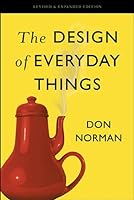
The Design of Everyday Things

A usable design starts with careful observations of how the tasks being supported are actually performed, followed by a design process that results in a good fit to the actual ways the tasks get performed. The technical name for this method is task analysis. The name for the entire process is human-centered design (HCD), discussed in Chapter 6.
Donald A. Norman • The Design of Everyday Things
The lack of clear communication among the people and organizations constructing parts of a system is perhaps the most common cause of complicated, confusing designs.
Donald A. Norman • The Design of Everyday Things
Known cultural norms can create comfort and harmony. Unknown norms can lead to discomfort and confusion.
Donald A. Norman • The Design of Everyday Things
Conventions are actually a form of cultural constraint, usually associated with how people behave. Some conventions determine what activities should be done; others prohibit or discourage actions. But in all cases, they provide those knowledgeable of the culture with powerful constraints on behavior.
Donald A. Norman • The Design of Everyday Things
Strangely enough, the inside door handles for automobiles tell a different story. Here, the designer has faced a different kind of problem, and the appropriate solution has not yet been found. As a result, although the outside door handles of cars are often excellent, the inside ones are often difficult to find, hard to figure out how to operate,
... See moreDonald A. Norman • The Design of Everyday Things
Semantics is the study of meaning. Semantic constraints are those that rely upon the meaning of the situation to control the set of possible actions.
Donald A. Norman • The Design of Everyday Things
Why does inelegant design persist for so long? This is called the legacy problem, and it will come up several times in this book. Too many devices use the existing standard—that is the legacy. If the symmetrical cylindrical battery were changed, there would also have to be a major change in a huge number of products.
Donald A. Norman • The Design of Everyday Things
Physical limitations constrain possible operations. Thus, a large peg cannot fit into a small hole.
Donald A. Norman • The Design of Everyday Things
Constraints are powerful clues, limiting the set of possible actions. The thoughtful use of constraints in design lets people readily determine the proper course of action, even in a novel situation.